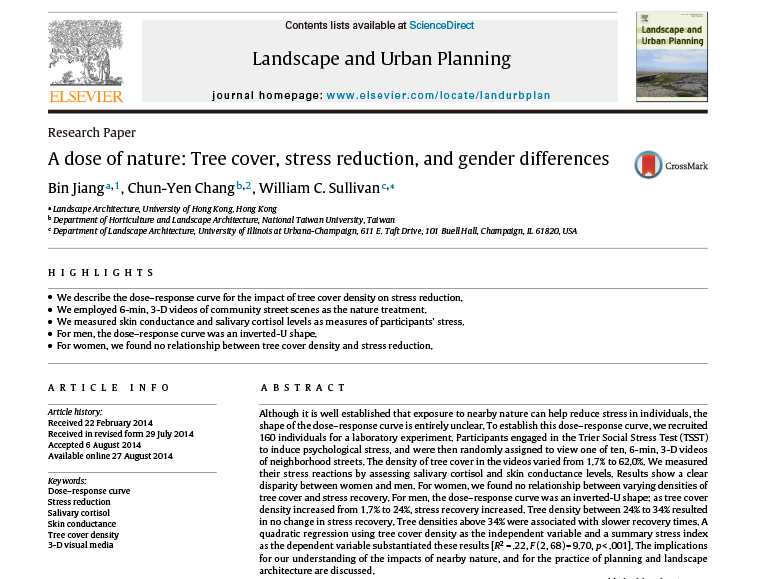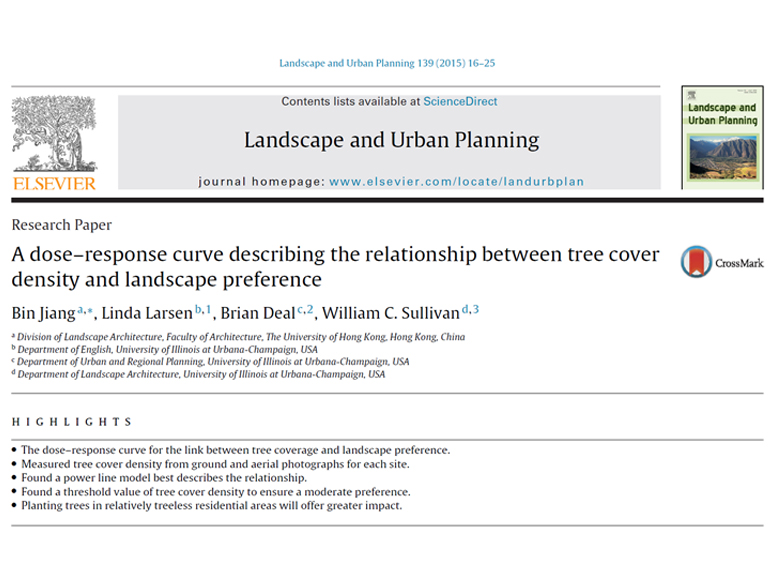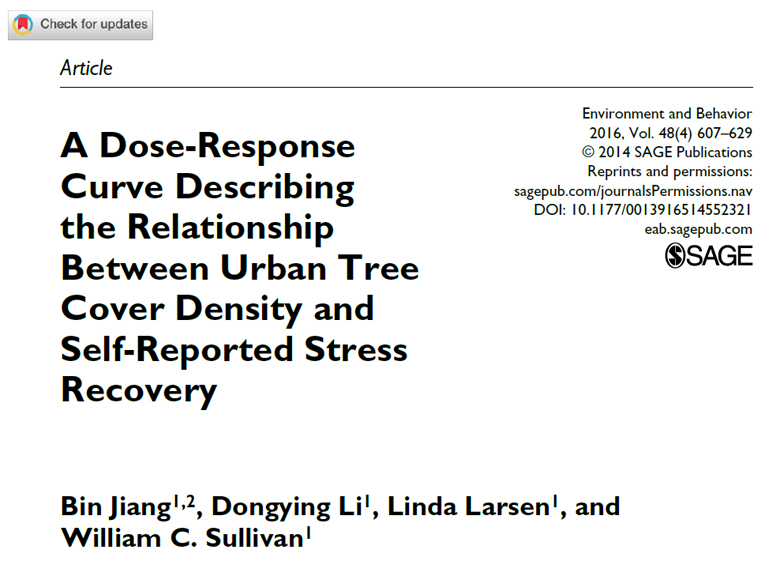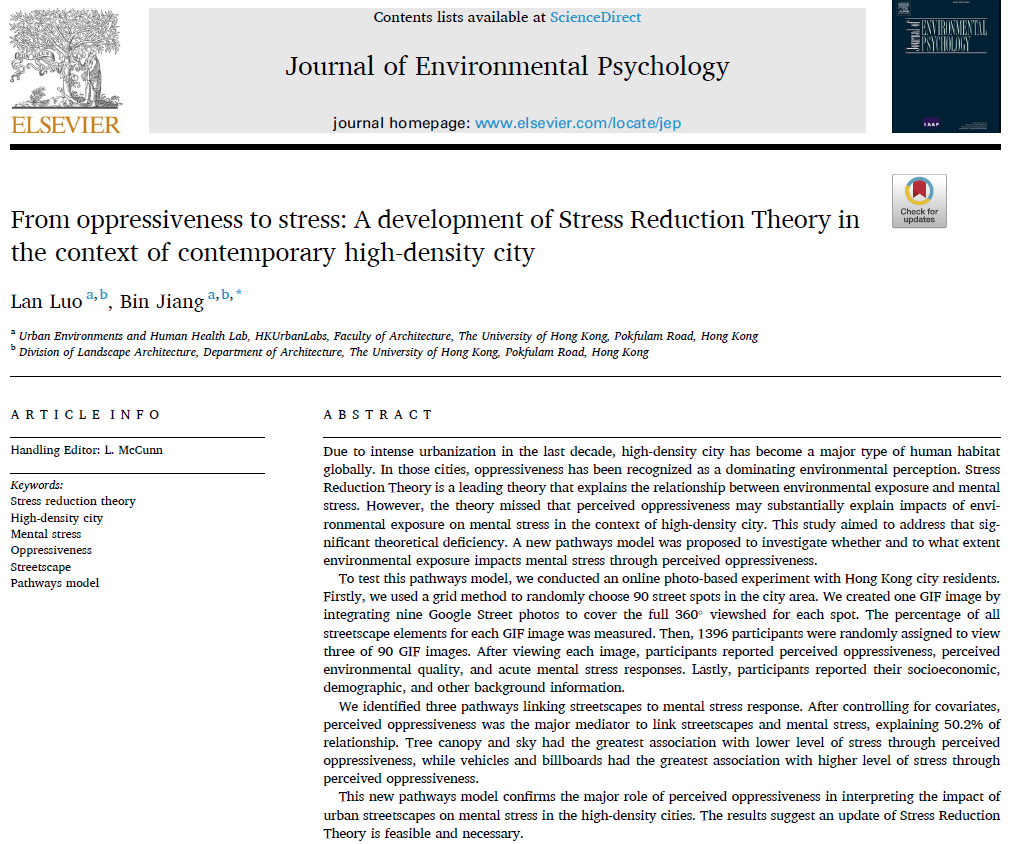Dose of Nature and Mental Restoration
Journal Artical
A Dose of Nature: Tree Cover, Stress Reduction, and Gender Differences
Landscape and Urban Planning, 2014, IF= 8.119
Although it is well established that exposure to nearby nature can help reduce stress in individuals, the shape of the dose–response curve is entirely unclear. To establish this dose–response curve, we recruited 160 individuals for a laboratory experiment. Participants engaged in the Trier Social Stress Test (TSST) to induce psychological stress, and were then randomly assigned to view one of ten, 6-min, 3-D videos of neighborhood streets. The density of tree cover in the videos varied from 1.7% to 62.0%. We measured their stress reactions by assessing salivary cortisol and skin conductance levels. Results show a clear disparity between women and men. For women, we found no relationship between varying densities of tree cover and stress recovery. For men, the dose–response curve was an inverted-U shape: as tree cover density increased from 1.7% to 24%, stress recovery increased. Tree density between 24% to 34% resulted in no change in stress recovery. Tree densities above 34% were associated with slower recovery times. A quadratic regression using tree cover density as the independent variable and a summary stress index as the dependent variable substantiated these results [R2 = .22, F (2, 68) = 9.70, p < .001]. The implications for our understanding of the impacts of nearby nature, and for the practice of planning and landscape architecture are discussed.
A Dose–response Curve Describing the Relationship Between Tree Cover Density and Landscape Preference
Landscape and Urban Planning, 2015, IF= 8.119
Does adding more and more trees to a residential street yield a reliable increase in preference? Or is there a point at which, in terms of preference, additional trees will have minimal effect, no effect, or even a negative effect? To address these questions, we selected 121 community streets in four Midwestern urban areas in the U.S. and produced a panoramic photograph of each site and then measured the density of tree cover visible at eye level (Panorama). We also collected Google Earth aerial photographs to measure the top-down tree cover density (Google) for the sites. Then, 320 individuals provided preference ratings for a randomized subset of the panoramic photographs (15 pictures per person). Through linear and curvilinear regression analysis, we found a power line model best describes the relationship between each measure of tree cover density and preference. The power lines have a similar shape: when sites are relatively barren, a slight increase in tree density yields a steep increase in preference. After tree cover density exceeded those values, however, higher tree densities yielded smaller, but still positive increases in preference. These findings suggest that to ensure a moderate level of preference, tree cover density should be not less than 41% as measured by panoramic photographs or 20% as measured by Google Earth aerial photographs. Planting trees in barren residential areas will result in considerably more impact than if the same trees were planted in already green areas. Still, the findings here demonstrate that, for preference, every tree matters.
A Dose-Response Curve Describing the Relationship Between Urban Tree Cover Density and Self-Reported Stress Recovery
Environment and behavior, 2016, IF= 6.548
Although it is well established that viewing nature can help individuals recover from a stressful experience, the dose-response curve describing the relationship between tree cover density and stress recovery is totally unclear. A total of 160 participants engaged in a standard Trier Social Stress Test to induce stress. Participants were then randomly assigned to watch 1 of 10 three-dimensional videos of street scenes that varied in the density of tree cover (from 2% to 62%). Participants completed a Visual Analog Scale questionnaire at three points in the experiment. Analysis revealed a positive, linear association between the density of urban street trees and self-reported stress recovery, adjusted R2 = .05, F(1, 149) = 8.53, p < .01. This relationship holds after controlling for gender, age, and baseline stress levels. A content analysis of participants’ written narratives revealed a similar but even stronger association. These findings suggest that viewing tree canopy in communities can significantly aid stress recovery and that every tree matters.
From Oppressiveness to Stress: A Development of Stress Reduction Theory in the Context of Contemporary High-density City
Journal of environmental psychology, 2022, IF= 7.649
Due to intense urbanization in the last decade, high-density city has become a major type of human habitat globally. In those cities, oppressiveness has been recognized as a dominating environmental perception. Stress Reduction Theory is a leading theory that explains the relationship between environmental exposure and mental stress. However, the theory missed that perceived oppressiveness may substantially explain impacts of environmental exposure on mental stress in the context of high-density city. This study aimed to address that significant theoretical deficiency. A new pathways model was proposed to investigate whether and to what extent environmental exposure impacts mental stress through perceived oppressiveness.
To test this pathways model, we conducted an online photo-based experiment with Hong Kong city residents. Firstly, we used a grid method to randomly choose 90 street spots in the city area. We created one GIF image by integrating nine Google Street photos to cover the full 360° viewshed for each spot. The percentage of all streetscape elements for each GIF image was measured. Then, 1396 participants were randomly assigned to view three of 90 GIF images. After viewing each image, participants reported perceived oppressiveness, perceived environmental quality, and acute mental stress responses. Lastly, participants reported their socioeconomic, demographic, and other background information.
We identified three pathways linking streetscapes to mental stress response. After controlling for covariates, perceived oppressiveness was the major mediator to link streetscapes and mental stress, explaining 50.2% of relationship. Tree canopy and sky had the greatest association with lower level of stress through perceived oppressiveness, while vehicles and billboards had the greatest association with higher level of stress through perceived oppressiveness.
This new pathways model confirms the major role of perceived oppressiveness in interpreting the impact of urban streetscapes on mental stress in the high-density cities. The results suggest an update of Stress Reduction Theory is feasible and necessary.




